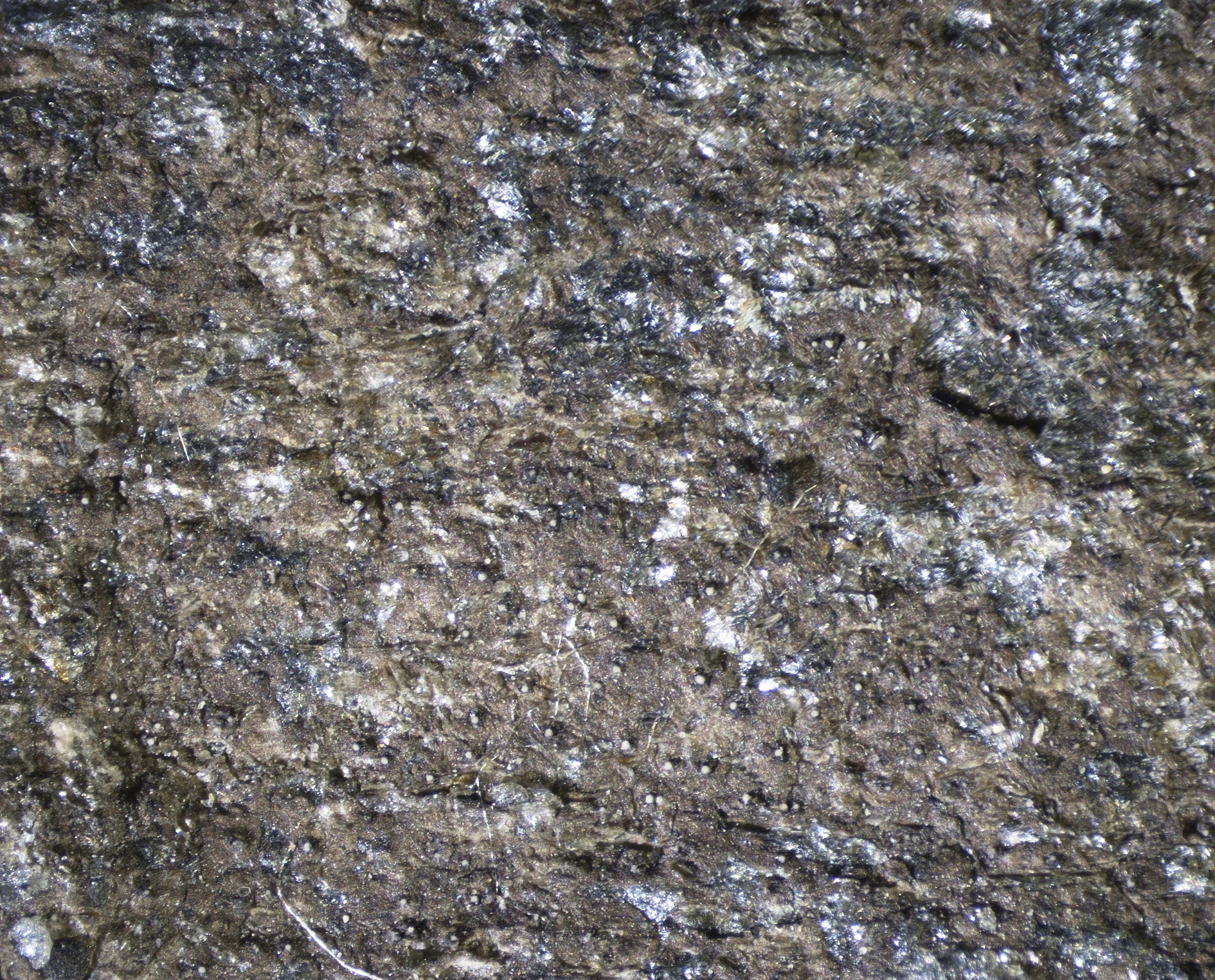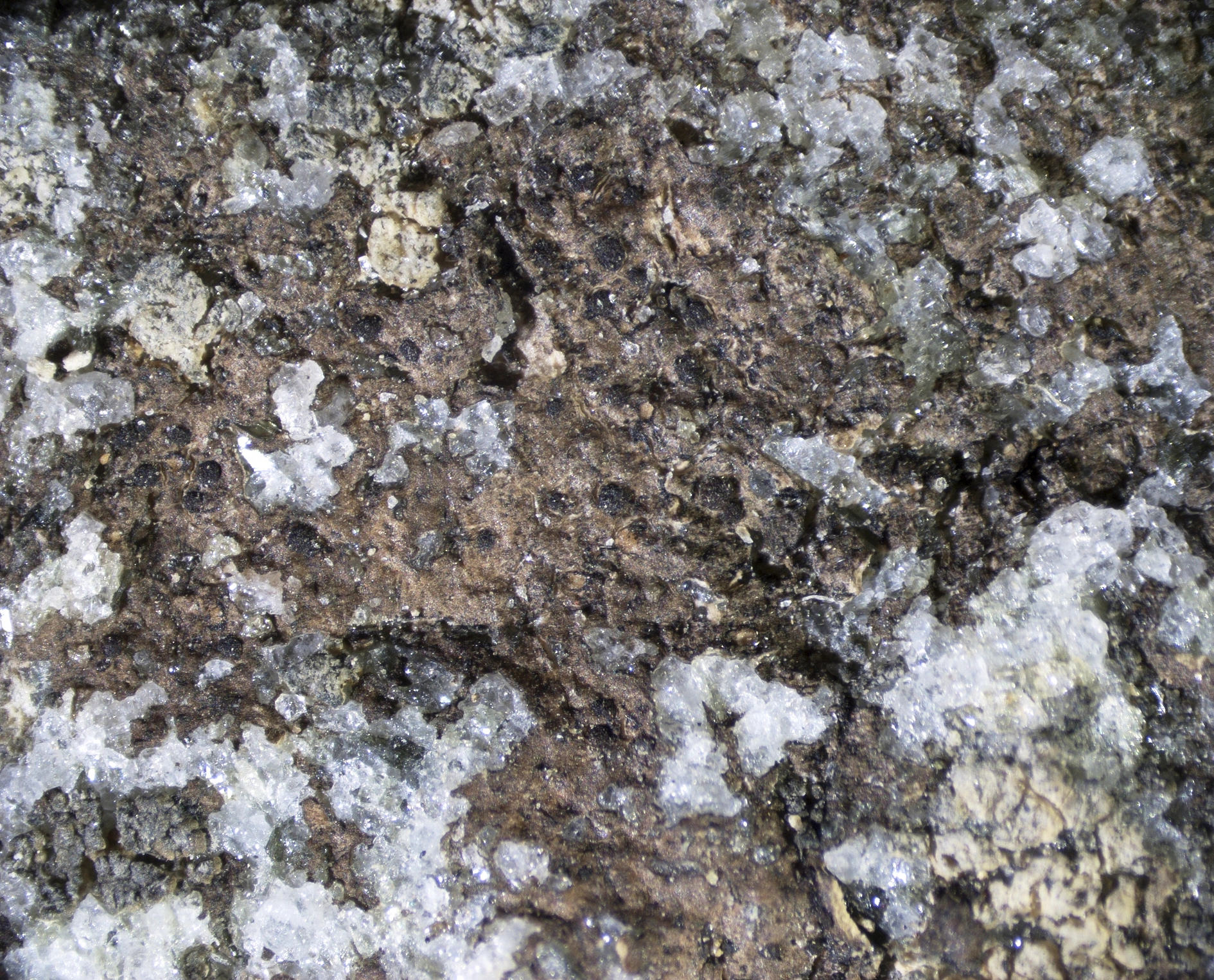Arthonia phaeobaea
Arthonia phaeobaea collected from coastal rocks near Brekka in Skaun (O-L-198129).
Arthonia phaeobaea grows in the supralittoral zone on rich or slightly calcareous coastal rocks along the Norwegian coastline. It is easily identified by pale brown to brown thalli with a faint mauve hue, and by the numerous brownish black pycnidia. The photobiont is chlorococcoid. The brown-black apothecia are often lacking. The colorless spores are 3–5-septate and lack an enlarged apical cell.
- Innhold
- Description
- Ecology
- Distribution in Norway and the Nordic countries
- Global distribution
- Similar species
Description
Thallus
The thallus is pale brown to brown with a faint mauve hue, continuous or slightly cracked, and up to 0.1 mm thick. It is often distinctly patch-forming but not determinate. The photobiont is a chlorococcoid alga.
Fruitbodies
The apothecia are maculate, brown-black, and without pruina. They are flat to slightly convex and immersed in the thallus to raised. They are 0.15–0.3 mm in size and 90–120 μm tall.
The epithecium is 5–8 µm tall and dark reddish brown.
The hymenium is colorless and 35–50 μm tall.
The hypothecium is colorless or pale yellowish brown, and 45–85 µm tall.
The paraphysoids are 1–1.5 μm wide and bear distinct brown pigment caps in the tips.
The asci are broadly obovoid, with stipe, 55–75 × 23–32 µm in size, and 8-spored.
The spores are colorless, cylindrical to narrowly obovoid, at least incised at the median septum, 17–30 × 5–7 μm in size, and divided by 3–5 transverse septa.
Anamorph
Pycnidia are always present and numerous. They are brownish black, immersed in the thallus and 40–80 µm in size. The wall is brown. The rod-shaped conidia are 4–5.5 × 1.5–2 μm in size and straight.
Chemistry
The thallus does not react with C, K, KC, Pd, or UV (C–, K–, KC–, Pd–, UV–). Lichen secondary compounds have not been detected by TLC.
The hymenium reacts I+ red and KI+ blue. A KI+ blue ring structure in the asci has been observed.
The brown pigments in epithecium and hypothecium do not change in K solution. In the wall of the pycnidia it changes to olive-brown in K solution.
Arthonia phaeobaea collected from coastal rocks near Mosterhavn in Bømlo (O-L-67845).
Ecology
Arthonia phaeobaea grows in the supralittoral zone on exposed coastal rocks. It seems to be confined to rich or slightly calcareous rock types, avoiding rocks that are too nutrient-poor or acidic.
Distribution in Norway and the Nordic countries
Arthonia phaeobaea occurs along the Norwegian coastline from Rogaland to Troms og Finnmark, but it is not a common species. In the Nordic countries, it is further known from Denmark, Finland (rare) and Sweden.
Global distribution
Outside the Nordic Countries, A. phaeobaea is known from coastal western Europe including the British Islands, Iceland and North America.
Arthonia phaeobaea collected from coastal rocks near Saltstrømmen in Bodø (O-L-67868).
Similar species
Arthonia phaeobaea is easily identified in its habitat by pale brown to brown thalli with a faint but usually distinct mauve hue, and by the numerous brownish black pycnidia. The dark reddish brown to brown-black apothecia are often lacking. It cannot be mistaken for any other species in Norway.
Literature
Cannon P, Ertz D, Frisch A, Aptroot A, Chambers S, Coppins BJ, Sanderson N, Simkin J and Wolseley P (2020). Arthoniales: Arthoniaceae. Revisions of British and Irish Lichens 1: 1–48.
Wirth V, Hauck M and Schultz M (2013). Die Flechten Deutschlands, vol. 1+2. Ulmer, Stuttgart. 1244s.


